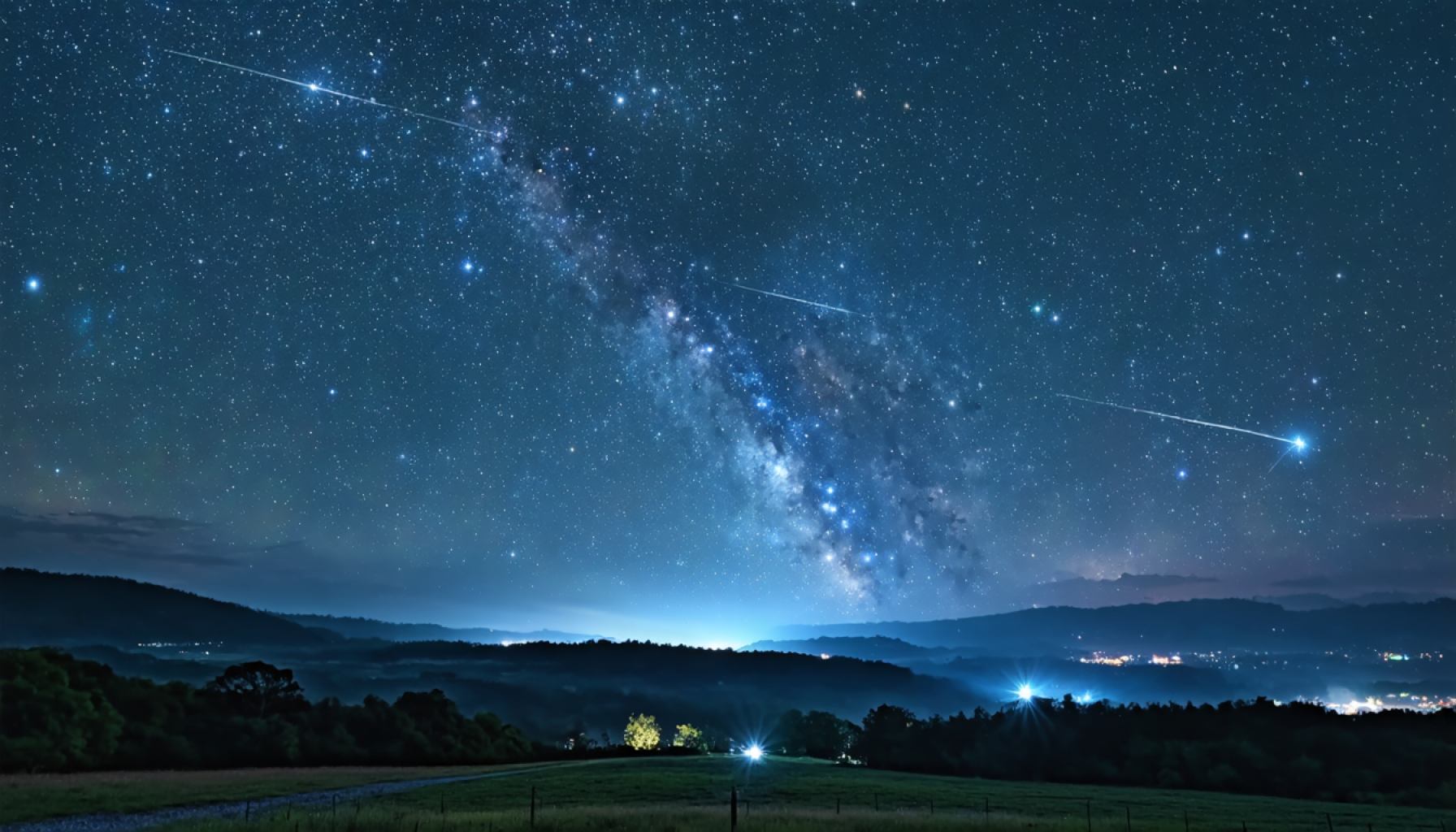
The Celestial Dance: How to Experience the Magic of the Lyrid Meteor Shower
- The Lyrid meteor shower peaks on April 25, 2025, offering a visually stunning celestial display with around 15 meteors per hour.
- Due to a crescent moon only 27% full, reduced moonlight allows an unobstructed view of the meteor show against a dark sky.
- No telescopic equipment is needed; the naked eye suffices for viewing.
- The event is best viewed from the Northern Hemisphere, though some southern locations may also catch a glimpse.
- Optimal viewing times start after 10 p.m., peaking at 5 a.m., with the best spectacle before 3:30 a.m. moonrise.
- Lying back facing east and allowing eyes to adjust for 45 minutes enhances meteor visibility.
- The experience provides a moment for personal reflection, connecting viewers to an ancient astronomical tradition.
A celestial ballet is poised to enchant stargazers on April 25, 2025, as the Lyrid meteor shower graces the night sky. This annual cosmic event, which has intrigued humanity for over 2,500 years, reaches its zenith, promising a captivating display of shooting stars that will dazzle the eyes of those fortunate enough to catch a glimpse.
Visualize the scene: the sky illuminated with fleeting meteors, each leaving behind a trail of shimmering, ephemeral light. The Lyrids are renowned for their dependability, and this year, enthusiasts can expect to see approximately 15 meteors per hour, with the possibility of brighter meteors painting the sky with glowing streaks that linger just long enough to etch themselves into memory.
Thanks to a fading crescent moon, only 27% full, viewers will experience an unspoiled spectacle, where the astral phenomena dance vividly against a backdrop of deep darkness. NASA highlights that this reduced moonlight transforms the night into a canvas where meteors can freely perform their luminous choreography.
While the shower favors the Northern Hemisphere, hopeful viewers in select southern locales might also manage to partake in this astral festivity. No telescopic gear is necessary for the display—just the naked eye, away from the blinding lights of urban sprawl, is enough to appreciate the natural wonder overhead.
Experts recommend venturing out after 10 p.m. local time on Monday, ready to brave the chill of night into the wee hours of dawn on Tuesday. Optimal viewing occurs around 5 a.m., when the sky plunges into its deepest darkness, but aim to catch the spectacle before the moon ascends around 3:30 a.m.—the perfect time for personal reflection amid nature’s grand performance.
For the best results, lie back facing east, and allow your eyes to acclimate to the night’s embrace for approximately 45 minutes. In this way, even the most furtive meteors will not escape your vigilant gaze.
Prepare to be dazzled by the Lyrids’ display—a reminder of the universe’s grandeur and our small place within it. As ancient as the stars themselves, these meteors connect us to generations past who have marveled at the very same sky. Venture beyond the city lights, cast your gaze upward, and witness the sky’s very own fireworks—a breathtaking manifestation of nature’s enigmatic beauty.
How to Maximize Your Experience During the 2025 Lyrid Meteor Shower
Understanding the Lyrid Meteor Shower
The Lyrid meteor shower is one of the oldest known meteor showers, with records dating back over 2,500 years. This annual event occurs when the Earth passes through the debris left by the long-period Comet C/1861 G1 Thatcher. Named after the constellation Lyra from which they appear to radiate, the Lyrids typically occur from April 16 to April 25, reaching their peak around April 22.
Tips for Optimal Viewing of the Lyrid Meteor Shower
1. Choose the Right Time: The Lyrids are best viewed in the pre-dawn hours. While the zenith is expected early in the morning on April 22, 2025, it’s advisable to be prepared from late night on April 21. Aim to view between 2 a.m. and 5 a.m., when the sky is at its darkest.
2. Avoid Artificial Lights: To fully enjoy the meteor shower, it is crucial to find a location far from the light pollution of urban areas. Rural or remote settings provide the darkest skies.
3. Prepare Your Equipment: No specialized equipment such as telescopes is necessary; however, binoculars may enhance viewing comfort for some. A reclining chair or blanket can help you comfortably watch the sky for extended periods.
4. Warm Clothing and Snacks: April nights can be chilly, so dress warmly, and consider bringing a thermos of hot drink and some snacks to enjoy as you marvel at the meteor display.
5. Let Your Eyes Adjust: Avoid looking at any artificial lights for at least 20-30 minutes before viewing the sky to allow your eyes to fully adjust to the dark.
Real-World Use Cases of Meteor Viewing
Meteor showers can be the perfect opportunity for photography enthusiasts to capture breathtaking long-exposure shots of the night sky. Astrophotographers recommend using cameras with wide-angle lenses set with long-exposure settings to capture the streaks of light.
Market Forecasts & Industry Trends in Astronomy Equipment
The fascination with astronomical events is driving the growth of the stargazing equipment market. As awareness and interest in space and celestial events grow, companies such as Celestron and Orion report increasing sales for amateur telescopes and accessories. The market is projected to grow steadily as more people take up stargazing as a hobby.
Controversies & Limitations
While the beauty of meteor showers is universally admired, they sometimes spark debate about light pollution’s impact on viewing. Increased urban development means more people struggle to find dark skies, emphasizing the need for dark sky conservation measures.
Conclusion: Quick Tips
– Find a dark sky location and check weather forecasts to ensure clear skies for the best viewing experience.
– Plan ahead for a late-night or early-morning excursion.
– Remember, patience is key—take the time to fully enjoy this annual cosmic event!
For more fascinating celestial events, visit NASA for the latest updates on space phenomena and related information.
Comments (0)